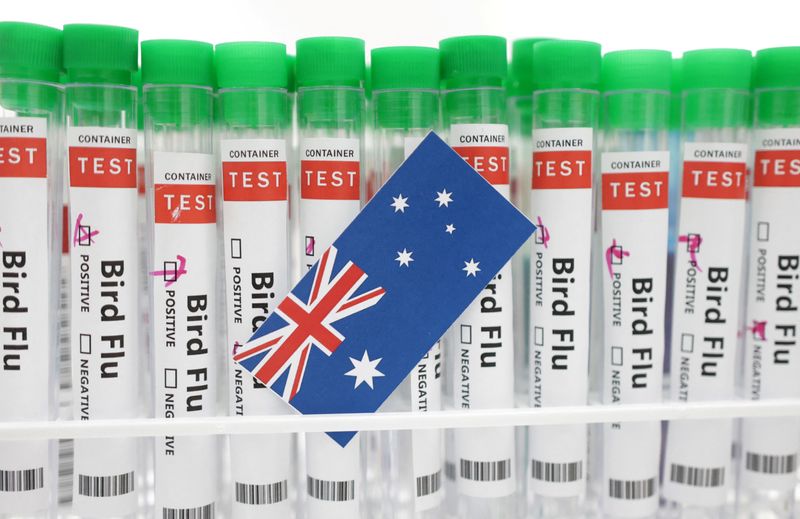Australia, New Zealand brace for looming bird flu threat
Reuters
Published Oct 09, 2024 12:22AM ET

By Peter Hobson and Lucy Craymer
CANBERRA/WELLINGTON (Reuters) - Australia and New Zealand are bracing for the arrival of a destructive bird flu strain by tightening biosecurity at farms, testing shore birds for disease, vaccinating vulnerable species and war-gaming response plans.
Oceania is the last region of the world free of the H5N1 clade 2.3.4.4b avian influenza that has killed hundreds of millions of birds and tens of thousands of mammals since appearing in Asia, Europe and Africa in 2020, littering beaches with corpses and upending the agricultural industry.
While the region is somewhat protected by its geography - it is off the migration routes of big birds such as geese that spread infection - the virus is close, having reached Indonesia in 2022 and Antarctica last year.
Scientists and officials say there is a higher risk, particularly in Australia, of it arriving with smaller migratory shore birds during the Southern Hemisphere springtime months from September to November.
"It is clearly a threat to our country's ecosystems," said Fiona Fraser, Threatened Species Commissioner at Australia's environment ministry.
"Many of our species are found nowhere else in the world," she said. "Vulnerable species may face long-term population setbacks and heightened risk of extinction."
Officials fear mass deaths from the avian flu and even the near-extinctions of species including endangered sea lions, black swans and many types of seabird, and the loss of millions of farmed poultry.
Over 100 million chickens and turkeys have died or been culled in the United States alone from this H5N1 strain, causing economic losses of up to $3 billion by the end of last year, according to the Council of Foreign Relations, a U.S. think tank.
The virus killed around 50,000 seals and sea lions and more than half a million wild birds as it moved through South America beginning in 2022.
It has also infected cattle in the United States and, in rare cases, people. Health officials say the risk to humans is low.
New Zealand is also unlikely to avoid the virus long-term, said Mary van Andel, chief veterinary officer for the country's Ministry of Primary Industries.
"Geographic isolation has protected us from HPAI (high pathogenicity avian influenza) in the past, but we can't rely on it forever," she said.
'WARTIME'
Both countries have intensified preparation.
Australia created a task force across government departments and stress-tested its preparedness in August and September with a series of exercises simulating an H5N1 outbreak in wildlife.
New Zealand has trialled a vaccine on five endangered native birds and said it could be rolled out to more species.
"We're super paranoid about those five species, because the risk to them of losing the breeding population is that we could lose the species," said Kate McInnes, science advisor at New Zealand's Department of Conservation.
Australia is also developing options for vaccinating threatened wild birds held in captivity, officials said. The two vaccination schemes are among the only ones for non-farmed animals in the world.
Farms are boosting biosecurity measures including limiting contact between poultry and wild birds, monitoring employees' movement, sterilising water and equipment and installing automated systems that detect wild birds and scare them away, industry officials from both countries said.
While Australia has had numerous outbreaks of highly pathogenic bird flu strains in poultry flocks, including earlier this year, they were less-virulent strains that did not spread through wild birds.
New Zealand has never faced high pathogenicity bird flu. Its poultry industry association has organised trips to both Australia and Britain to learn from farms there.
"We've been at peacetime," said Poultry Industry Association New Zealand Executive Director Michael Brooks. "Frankly, now we're potentially heading to wartime."
Oceania has had longer than other regions to prepare for the arrival of H5N1, but while the poultry industry can lock down, wild populations cannot be contained.

"We've learned a lot from the way the disease has spread across the world. We've stepped up our preparedness as best we can," said Brant Smith, an official at Australia's agriculture ministry overseeing the country's response.
"But every single continent has seen huge mortality events in wildlife. We are likely to see this occur here too."
Written By: Reuters
Trading in financial instruments and/or cryptocurrencies involves high risks including the risk of losing some, or all, of your investment amount, and may not be suitable for all investors. Prices of cryptocurrencies are extremely volatile and may be affected by external factors such as financial, regulatory or political events. Trading on margin increases the financial risks.
Before deciding to trade in financial instrument or cryptocurrencies you should be fully informed of the risks and costs associated with trading the financial markets, carefully consider your investment objectives, level of experience, and risk appetite, and seek professional advice where needed.
Fusion Media would like to remind you that the data contained in this website is not necessarily real-time nor accurate. The data and prices on the website are not necessarily provided by any market or exchange, but may be provided by market makers, and so prices may not be accurate and may differ from the actual price at any given market, meaning prices are indicative and not appropriate for trading purposes. Fusion Media and any provider of the data contained in this website will not accept liability for any loss or damage as a result of your trading, or your reliance on the information contained within this website.
It is prohibited to use, store, reproduce, display, modify, transmit or distribute the data contained in this website without the explicit prior written permission of Fusion Media and/or the data provider. All intellectual property rights are reserved by the providers and/or the exchange providing the data contained in this website.
Fusion Media may be compensated by the advertisers that appear on the website, based on your interaction with the advertisements or advertisers.